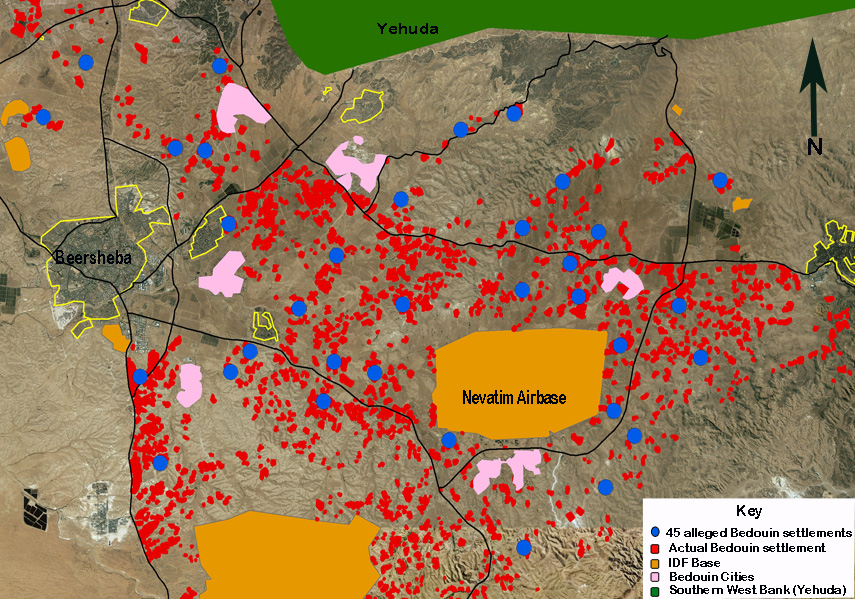GIVING AWAY THE NEGEV
Compiled from articles by Smadar Bat Adam and AFSI
Background
[T]he Israeli Knesset voted last week to give away the Negev to the Bedouins. The AFSI Chizuk missions have traveled through the Bedouin Triangle of Arad, Beersheva and Dimona in the Negev with Ari Briggs of Regavim. Ari showed us the illegal Bedouin building throughout the area which the Israeli government is now legalizing. He also showed us the cities, schools, and hospitals built by the Israeli government for the Bedouins. All of this is on state owned land or private land owned by Jews. No such accommodations are made for Jews.
In this video, Judith Nusbaum of UCI interviews Ari Briggs about worrisome territorial facts that are being created: the State of Israel is losing its possession of national lands to the illegal Bedouin land-grab.
In less than two months, eight years will have passed since the process of "disengaging" or what some call "uprooting" of tens of thousands of Jews from the Gaza Strip. We are talking about citizens of the country, who bought their homes legally, and invested most of their money in building their lives there. The fact that they were law-abiding citizens did not help the residents of Gush Katif.
The government made a decision and received the approval of the High Court, allowing for the implementation of a time frame in which it would be impossible to rehabilitate the displaced population; and so the eviction was carried out.
Though the evictions were carried out with a sense of purpose and sensitivity [Many would question "sensitivity". Unlike the current plan for the Bedouin, the government had made no specific plans on housing and rehabilitating the Gazan Jews. They destroyed a innovative and patriotic community and even today, many have not yet been rehabilitated and are still living in temporary quarters — BSL], the operative words here are that the evictions were carried out. The promised rehabilitation has dragged out to this day. And the one thing the government succeeded in proving was that it does what it wants. [When it wants to. And when it isn't afraid of "world opinion." It is more likely that Jewish settlements will be uprooted than Bedouin ones. — BSL]
If you want to understand what is going on there, look at the aerial photographs. A bird's eye view makes the picture clear. Bedouin groups have taken over. Every year, some 2,000 illegal buildings go up. Tin shacks, cement buildings, every sort of structure, and in between Jewish National Fund trees, and soldiers keeping guard, along the borders.

The Law for Bedouin Settlement is meant to instill order in Israel's wild southern desert. A large ethnic group numbering around 220,000, the Bedouin population is undergoing metamorphosis. From nomadic desert tribes to house dwellers holding land. The Bedouin say, "Here I was born, here my children were born, here I built my home with my own two hands; so I do not have a deed, so what?"
To assist the Bedouin to integrate into Western life on recognized lands, the city of Rahat was established, the decision was made to enforce the law against illegal takeover of lands, and the Authority for the Settlement of the Bedouin in the Negev was established. Following this, a committee on the subject was established, headed by retired judge Eleazar Goldberg. He suggested this solution: a program to "whitewash" the illegal takeovers of land by recognizing existing villages, and by giving high cash payouts to those requested to clear out of their homes and settle elsewhere by the state.
The first reading of the law passed in a close vote this week (43-40), and was placed in the care of former minister Benny Begin. It basically said the Bedouin would be reimbursed either in money or land for some 950,000 dunams (950 square kilometers, or 240,000 acres). For the sake of comparison, Holon, the fifth biggest city in Israel, has some 200,000 residents on 19,200 dunams (4,700 acres). The law promised the Bedouin new lives, and rights to a variety of settlement options: city or village land, as agreed upon between the government and the Bedouin population. There would be an investment in water and sewage systems, an electrical grid, transportation, education, and in sources of income. A real revolutionary change.
Begin went from tribe to tribe, and laid it all out to the government only after he knew in good faith that the Bedouin with whom he had spoken were on board with the idea.
The protests that broke out under the banner of "pulling Bedouin from their lands" grew. There is no reason to get into the behavior of Arab Knesset members, who never showed a care for promotion of the welfare of Israel's Arabs. As loyal Palestinians, they will never miss an opportunity to take an opportunity.
From the side of justice, the program is problematic. It rewards the lawbreakers. It dramatically limits the options for development and establishment of additional Jewish settlements. From a commonsense perspective, the Knesset members are required, in between committees and the second and third readings to make substantial corrections that promise fair and quick solutions to the Bedouin population, which according to the latest estimates, will double its numbers in the next 13 years.
The AFSI version, "We've lost the Negev — What Happens Next?"
was posted June 27, 2013 at www.afsi.org by Helen Freedman, Executive
Director of AFSI. It included a sizable portion of an article by
Smadar Bat Adam, entitled "Instilling Order in the Wild Negev," which
was published June 27, 2013 in Israel Hayom and is archived at
http://unitycoalitionforisrael.org/news/?p=9631.